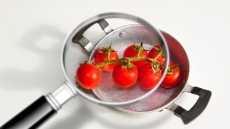US warming to air chilled chicken
chilling equipment to meet EU import requirements for the product,
with more expected to follow, according to USDA researchers.
While immersion chilling is still the predominant method of ensuring poultry quality in the US, researchers noted that plants switching to air chilling might find new markets in Europe, in a report published in the April 2008 edition of the Agricultural Research Magazine. In a separate paper for the USDA one of the researchers said that European Union trade restrictions on immersion chilled poultry have caused processors to consider air chilling as a viable option. In 2006, organic poultry company Elite Foods claimed that its North Carolina processing plant was the first in the US to use air chilling methods. The company said then that air chilling eliminated water retention in poultry, which extended its shelf life and enriched its flavour. Research In the Agricultural Research Magazine report, the researchers examined and compared air chilling and immersion chilling methods to ascertain the best method for ensuring meat quality, food safety and water management. They concluded that air chilled chicken can be processed quicker whilst maintaining meat quality, while also providing higher cooked meat yields and using less water than immersion chilled poultry. However, the researchers said that they found no significant difference in bacterial pathogen levels between the two chilling methods Meat Quality The researchers said that during commercial processing, whole carcasses are aged under refrigerated conditions to allow for muscle fibres to relax and become tender. The researchers then tested chicken breasts by comparing tenderness of fillets removed from carcasses immediately after chilling to those aged on carcasses for 150 minutes and 24 hours. After 24 hours of aging, the report said that both air and immersion chilling methods resulted in tender or very tender meat, but there were differences for shorter aging times. One of the researchers said that shorter aging times are of interest because plants have limited space to store carcasses after chilling and the additional holding time is costly. Immersion-chilled and air-chilled fillets were de-boned immediately after chilling and after 150 minutes. It was found that 70 per cent of the immersion-chilled fillets were slightly tough to tough and 30 per cent were tender to very tender. Of the air-chilled fillets, 44 per cent were found to be slightly tough, to tough and 56 per cent were tender, to very tender. A researcher noted that air chilling might therefore be "a suitable alternative for deboning and other processing operations." Cooked meat yield Air chilling produced a higher cooked meat yield because, researchers stated, the immersed meat absorbed a higher level of moisture during chilling, which was then cooked out. Water usage "The two poultry chilling methods vary markedly in their water use", said the report. Immersion chilling requires almost three quarters of a gallon of water per bird to fill the chill tank and another half-gallon of overflow. The researchers estimated that air chilling would save a minimum of one half gallon of water for each bird processed. This is of particular importance when areas experience drought. Also, according to William Merka, a former professor at the University of Georgia, processors pay at least $4 (€ 2.5) for every 1000 gallons of water and sewer costs. "If they can save even half a cent per bird with water conservation, that would save about $1.250 per day," he stated. Also whilst air chilling might seem a more sustainable solution, the researchers noted that air chilling takes 90 to 150 minutes longer that immersion chilling to complete hence the energy expended in air chilling is significant. The researchers noted: "If you consider time, energy cost and yield, the two processes are economically equivalent" Currently air chilled poultry is more expensive for consumers to buy. However, if air-chilled poultry products become commonplace the price will drop "and there will no longer be an economic advantage to producing air-chilled poultry", said one of the researchers. The research was carried out by Julie Northcutt and Doug Smith at the Richard B Russell Agricultural Research Center in Athens, Georgia, a research unit of the USDA Agricultural. Source: Agricultural Research Magazine April 2008 "Chillin' Chickens - Which Method Works Best?" Authors: Julie Northcutt and Doug Smith




















